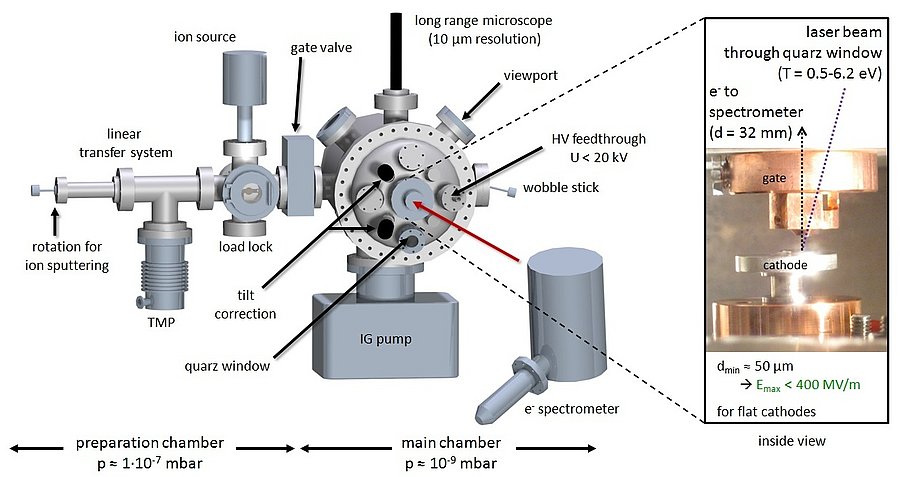Photo-Feldemissionsspektroskop (PFES):

Photo-Feldemissionsspektroskop
The ultra-high vacuum system for photo-induced field emission spectroscopy consists of a preparation chamber with sample load-lock and an analysis chamber, separated by a gate valve. The preparation chamber houses a linear transfer system for the cathodes and different types of gates (mesh, hole) and an ion source for sputtering. The analysis chamber contains a triode configuration which consists of an adjustable-distance cathode system, a tiltable gate system and a fixed electron spectrometer. Cathodes can be illuminated through a quarz window with an OPO-laser (EKSPLA NT342A) which is installed outside the system. It is tunable from 210 to 2300 nm with 1 to 15 mJ in 3-5 ns pulses and 10 Hz repetition. The cathode is mounted on a support structure with piezo drive (zmax = 32 µm) for precise control of the electrode gap and a linear feedthrough rod for coarse gap setting (zmax = 50 mm, Δz = 30 µm) and in-situ cathode and/or gate exchange. Via the support rod heating and cooling (T = 77-700 K) is applicable. The gate holder is fixed on an isolating plate (Teflon) which can be tilted with high precision (θmax = ± 5°, Δθ = 0.003°) by means of two fine-thread screws on rotatable feedthroughs. For a minimum gap of 50 µm, fields up to 400 V/µm can be achieved on a flat cathode with the power supply (FUG HCN 35), actually limited by the feedthrough (U < 20 kV). The cathode is biased with batteries (-100 V < U0 < 0 V) to provide the electrons with surplus energy required for reaching of the spectrometer nozzle. The spectrometer (VG Clam 2, ΔE < 50 meV) consists of a long nozzle for electron focusing and retardation and a hemispherical deflector analyzer with adjustable aperture and pass energy. The emission current is measured with a Picoammeter (Keithley 6485) at the cathode against ground potential. Depending on the cathode alignment, type of gate and analyser aperture, the data acquisition time for a spectrum at constant voltage actually varies between 5 s and a few minutes.
